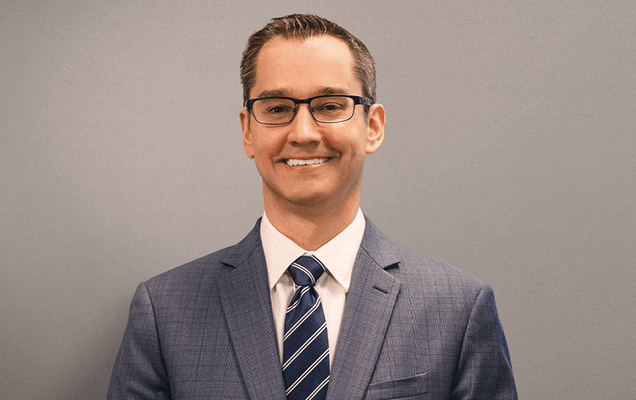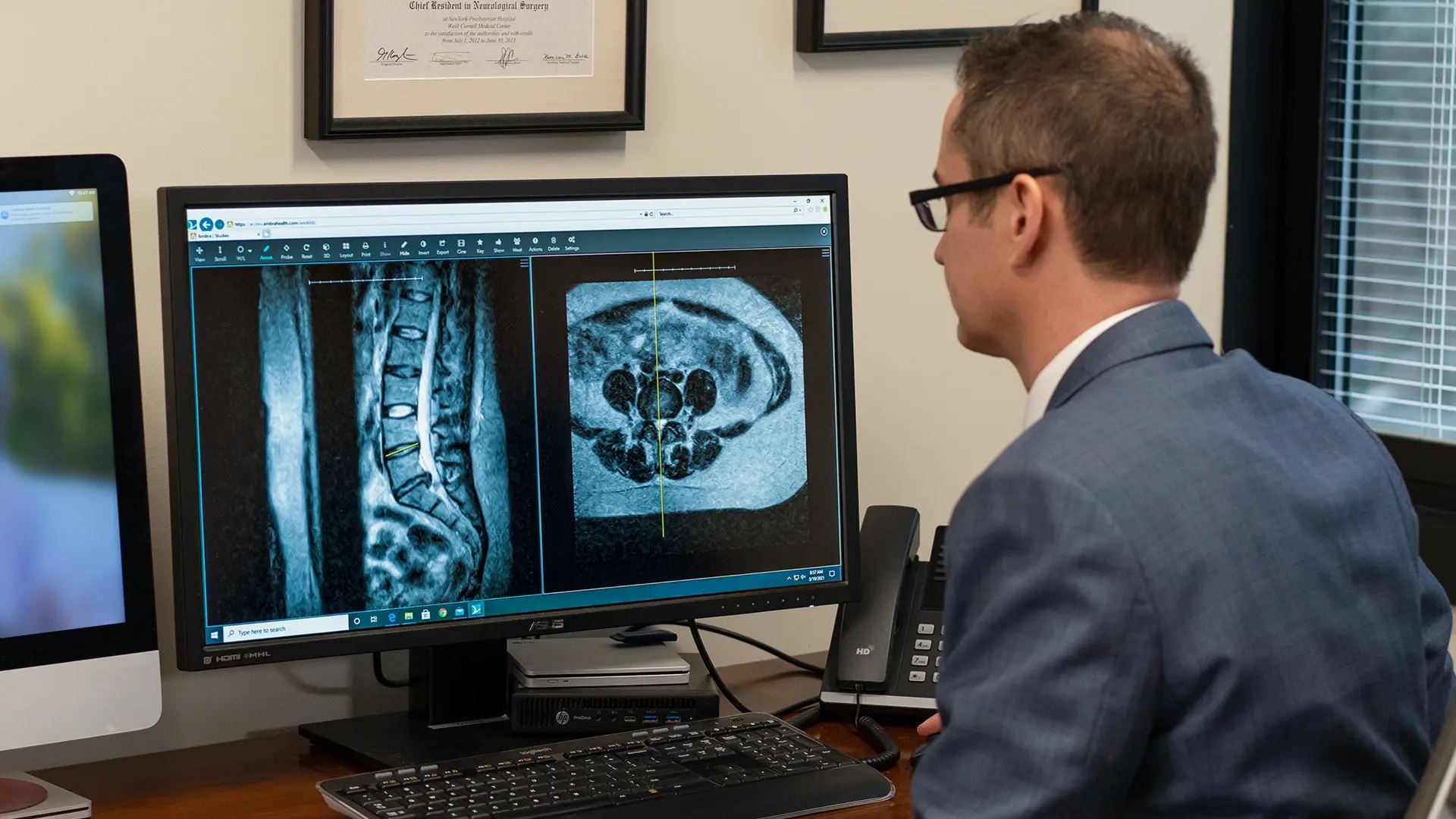Treatment of radicular leg pain with lumbar foraminotomy
Lumbar foraminal stenosis can cause significant pain and discomfort from a pinched nerve in the spine. Lumbar foraminotomy is a minimally invasive surgical procedure that can treat leg and sciatic pain associated with foraminal and spinal stenosis.
To better understand lumbar foraminotomy as a treatment, it is first important to understand the anatomy of the lumbar spine.
Overview of the Lumbar Spine
The lumbar spine, located in the lower back, consists of several vertebrae separated by intervertebral discs. These discs provide cushioning and flexibility to the spine. Additionally, pairs of facet joints connect the vertebrae, allowing for movement and stability.
The Importance of the Foramen
The foramen is a small opening on either side of the spinal column through which nerve roots exit the spinal canal. These exiting nerves travel through the foramen and branch out to various parts of the body, including the legs.
Nerve Compression and Leg Pain
Conditions such as bone spurs, herniated discs, and spinal stenosis can cause the narrowing of the foramen, leading to nerve compression. This compression can result in pain, numbness, tingling, or weakness in the legs.
What is a lumbar foraminotomy?
A lumbar foraminotomy is a minimally invasive spine surgical procedure. The purpose of this procedure is to decompress the spinal nerve in the low back that is causing radicular leg pain or sciatica. Crowding around the nerves leaving the spinal canal within a small opening or tunnel called the foramen can cause pain.
This is termed foraminal stenosis or spinal stenosis. This can happen through natural degenerative changes in the spinal column causing bone spurs, arthritic disease in the facet joints, disc bulging or disc herniations.
Pressure on the spinal cord and nerves can lead to pain experienced along the course of the nerve as it passes under the gluteus muscles and down the leg, oftentimes even without low back pain.
Initially, foraminal stenosis treatment consists of conservative therapies including physical therapy and medications. Should these methods fail, surgical decompression can help. A lumbar foraminotomy is a minimally invasive, same-day surgical procedure to relieve pressure on the nerve.
How is a lumbar foraminotomy done?
Lumbar foraminotomy is usually performed with minimally invasive techniques These involve smaller incisions and reduced disruption to the surrounding tissue. This approach offers several advantages, including shorter recovery times, less postoperative pain, and minimal scarring.
During surgery, the patient is typically placed under general anesthesia. The surgeon then makes a small incision near the affected area of the spine.
Through this incision, spine surgeons remove a small portion of the lamina bone to uncover the nerve below. Any bone spurs, facet joint arthritis or disc material contacting the nerve is removed to relieve pressure off the nerve.
After the necessary decompression is completed, the surgeon closes the incision using sutures or adhesive strips. The small size of the incision reduces the risk of complications and promotes faster healing.
What conditions does lumbar foraminotomy treat?
Lumbar foraminotomy can be used to treat many conditions. Some of these include:
- Bone Spurs: These bony growths can develop on the vertebrae and may encroach upon the foramen, compressing the nerve roots.
- Herniated Discs: When the gel-like center of an intervertebral disc protrudes and presses against the nerve roots.
- Spinal Stenosis: A narrowing of the spinal canal that leads to nerve compression and leg pain.
Are there other treatments available?
Surgery may not always be necessary and is a decision made by the patient and their healthcare team. In some cases, conservative treatments like physical therapy, medication, and lifestyle changes fail to alleviate leg pain caused by nerve compression. When this happens, surgery may be considered. Medical professionals carefully evaluate each patient’s specific symptoms and medical history to determine if spine surgery is appropriate.
Benefits and Risks of Lumbar Foraminotomy
Lumbar foraminotomy offers numerous benefits, including:
- Effective relief from leg pain and related symptoms.
- Minimally invasive approach with smaller incisions and reduced recovery times.
- Preservation of spinal stability and range of motion.
High success rates and patient satisfaction
Potential Risks and Complications
While lumbar foraminotomy is generally considered safe, there are potential risks associated with any surgical procedure. These risks may include infection, bleeding, nerve injury, or adverse reactions to anesthesia. However, complications are relatively rare and can be minimized by choosing an experienced surgeon and following postoperative care instructions.
Recovering from lumbar foraminotomy
Patients are usually up and walking immediately after surgery. Once the nerve is decompressed, pain or other symptoms improve within a few days to weeks.
Following surgery, patients are usually required to stay in the hospital for a brief period of observation. Pain medication and physical therapy may be recommended to manage pain and promote healing.
It's time to get back
to doing what you love.
Physical Therapy and Return to Normal Activities
Physical therapy plays a crucial role in the recovery process. A physical therapist will guide patients through exercises and stretches to improve flexibility, strength, and overall spinal health. Gradually, patients can resume their daily activities, taking care to follow any postoperative guidelines provided by their healthcare team.
Your doctor will inform you when it is safe to resume regular activities, such as driving. They will also advise when it is safe to return to work. It is important to follow these guidelines to help your spine heal properly.
Is lumbar foraminotomy right for me?
Lumbar foraminotomy is a minimally invasive surgical procedure that can effectively relieve leg pain and nerve compression caused by conditions such as bone spurs, herniated discs, and spinal stenosis.
By decompressing the affected foramen and relieving pressure on the nerve roots, this procedure provides significant relief to patients. With its shorter recovery times and reduced postoperative discomfort, lumbar foraminotomy offers a promising treatment option for individuals seeking relief from debilitating leg pain.
If conservative treatments have failed to provide satisfactory results, consulting with a healthcare professional to determine if lumbar foraminotomy is appropriate can be a vital step towards reclaiming a pain-free life.
There is no need to suffer in pain. Contact our office today to schedule a consultation with one of our board-certified surgeons.

About Dr. William S. Cobb
Dr. William Cobb is an accomplished neurosurgeon in North Jersey and a proud member of Neurosurgeons of New Jersey, practicing out of their Ridgewood office conveniently located on East Ridgewood Avenue. During his Neurological Surgery residency, he became passionate about the development and treatment of brain tumors affecting the brain and spine. Dr. Cobb uses state-of-the-art technology for surgical intervention in the treatment of tumors of the brain and spine including Gamma Knife radiosurgery. He has vast experience in using modern minimally invasive surgery for the treatment of degenerative spine and intervertebral disc disease. Dr. Cobb serves as the Director of Neurosurgical Oncology at Valley Hospital. He's accepting new patients.







